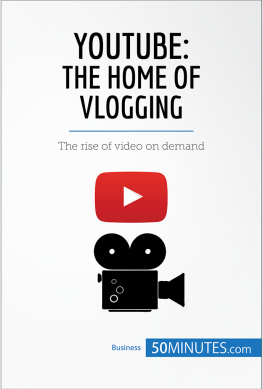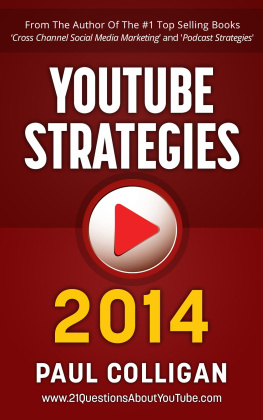YouTube: The Home of Vlogging
Whether they want to express a political opinion, learn how to fix their stove, watch a film clip or a music video by an artist from anywhere in the world, or find out more about the lifestyle of the inhabitants of an island on the other side of the globe, YouTube attracts an audience of a billion internet users who watch a total of six billion hours of video content hosted on the site each month and all for free!
What was originally envisioned as a simple video-sharing platform now accounts for nearly 4% of internet traffic worldwide. As such, there are some who do not hesitate to say that YouTube has changed the world by making it smaller and more universally accessible. It has opened new doors to fame and fortune, it has given a wide range of political causes and initiatives a voice, and it has revolutionised the way we think about entertainment and education.
Naturally, having dramatically altered the global audiovisual media landscape, YouTube came with the same slew of legal, financial and technical problems common to any new way of doing things. The website was purchased by the American internet giant Google less than two years after it was launched, and evolved in tandem with both the older corporation and the habits of the users who keep it alive. In 2015, YouTube celebrated its 10-year anniversary, and since then has increasingly been turning its attention towards cementing its position as the leader of the ultra-competitive but tremendously profitable sector of on-demand video, despite being faced with powerful competitors with near-bottomless funds to draw on.
Key information
- Founders: Chad Hurley (American entrepreneur, born in 1977), Steve Chen (Taiwanese-American entrepreneur, born in 1978) and Jawed Karim (German-American IT specialist and entrepreneur, born in 1979).
- Founded: the domain name youtube.com was registered on 14 February 2005.
- Commercial launch: a beta version of the site was launched in May 2005, and it officially went public in November of the same year.
- Sector: online video hosting.
- Key figures:
- June 2006: almost 20 million unique monthly visitors.
- October 2007: 100 million videos watched per day worldwide.
- October 2009: one billion videos watched per day.
- May 2010: two billion videos watched per day by an average of 500 million monthly visitors.
- October 2010: one billion subscribers to YouTubes user-created channels.
- May 2011: more than three billion videos watched per day; 48 hours worth of video content uploaded to the site per minute.
- May 2012: over 72 hours worth of video content watched on the site per minute; 4 billion videos watched per day worldwide by 800 million users (of whom 136 million originated from the United States).
- May 2013: one billion users; more than 100 hours worth of video content uploaded to the site per minute.
- November 2014: over 300 hours worth of video content uploaded to the site per minute.
- February 2017: over 400 hours worth of video content uploaded to the site per minute; one billion hours worth of video content watched per day.
- Key terms:
- Blog: a website where an internet user regularly publishes personal reflections or articles about a specific topic. The word was originally a portmanteau of the words web and log, and blogs have sometimes been likened to online journals. They are characterised by tremendous freedom of expression compared to institutional media outlets which follow a very particular editorial line, and by frequent interaction with readers through the use of hyperlinks, comments and links to social media.
- Vlog: this newer form of blogging uses videos as a medium, often in combination with captions or images, to approach all kinds of topics in an informal way. Today, YouTube is the most influential vlogging platform, and hosts the videos uploaded by the record-holder for the highest number of consecutive daily posts on a personal vlog: Charles Trippy, an American vlogger who has posted 3057 consecutive daily vlogs on YouTube as of 14 September 2017 (Guinness World Records, 2017).
- Copyright: a form of intellectual property law which grants the creator of a literary, artistic or scientific work, or the creators representative, the exclusive right to use and reproduce that work.
Context
From blogging
As recently as the early 2000s, creating websites and sharing content online was the sole domain of the IT elite with their expert knowledge of HTML, but this is almost unimaginable today.
HTML
The computing language HTML (HyperText Mark-Up Language) is one of the three key inventions which became the cornerstones of the internet in its earliest form, along with the HTTP protocol and web addresses. This standard language was developed in the early 1990s and allows the creator of a web document to include formatting and links to other web content while writing it.
Blogger.com was launched in August 1999 as a way to give ordinary people a voice on the internet. Most of the services offered by the platform are free of charge, making it extremely simple to publish content on the internet. Although it got off to a shaky start, the website went on to attract over a million users and was purchased by Google four years after it was created. This was a strategic acquisition for the web giant: at that point, blogging was steadily becoming more popular and seemed likely to trigger great changes in the way information was spread online. At a time when mainstream media was controlled by multinational corporations, the blog emerged as an indispensable means of communication for smaller associations and began springing up throughout the political sphere, in universities, and in the world of business. David Krane, who was the director of corporate communications at Google at the time, described it as a global self-publishing phenomenon that connects Internet users with dynamic, diverse points of view while also enabling comment and participation (Gillmor 2003).
to vlogging
YouTube was not the first online video hosting service to appear (for example, ShareYourWorld.com was launched in 1997), but it was the first site to opt for a novel means of operating. Previously, users had to download a file in order to view it, but streaming technology now makes it possible to view a video while it is being broadcast online. Furthermore, the site is free to use, unlike most other content hosting platforms which were available at that time, which generally operated on a system of paid subscriptions. Users can access the sites videos directly by using a web browser, without having to install and figure out how to use specific programmes for uploading or downloading content (images, music, videos, etc.) or to code, compress and format the files. Quite the contrary: once the files have been uploaded to the internet, sharing them on your own website or on social networks is childs play. From June 2005 onwards only four months after the website was launched it was already possible to embed a YouTube video player on any webpage.
Although many sites which were active at that time enabled users to share photos free of charge, most of them were primarily oriented towards selling personalised gifts or digital photo printing services. Meanwhile, although online video sharing had opened up a world of endless possibilities for internet users, the sector had not yet found a suitable economic model. Jakob Lodwick, one of the founders of Vimeo, the American community-based website founded in November 2004, admitted: We put up the site to see what would happen (Graham 2005).


















